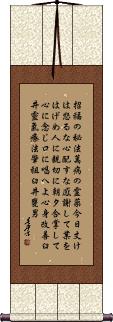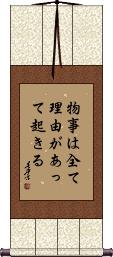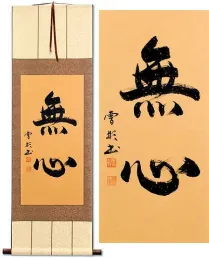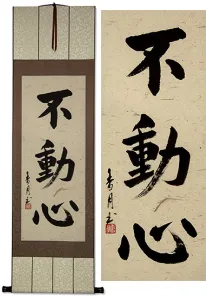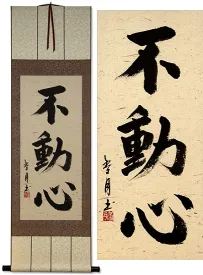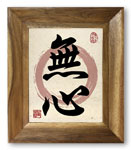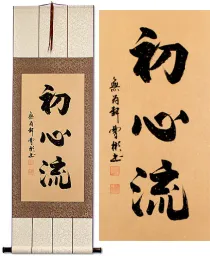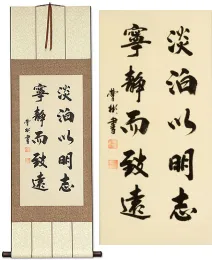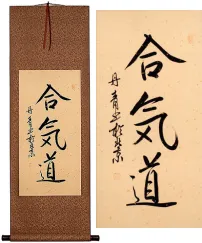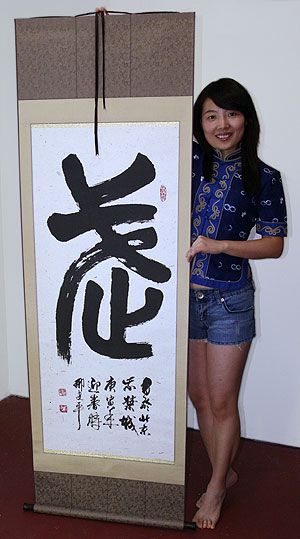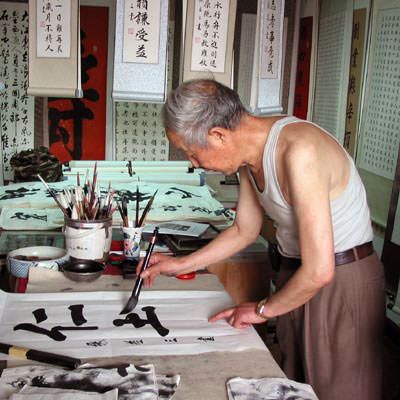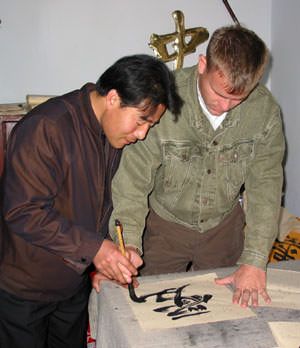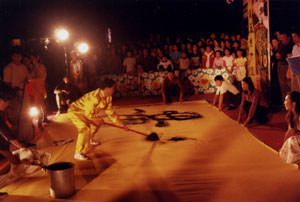Many custom options...
And formats...

Work Together With One Mind in Chinese / Japanese...
Buy a Work Together With One Mind calligraphy wall scroll here!
Personalize your custom “Work Together With One Mind” project by clicking the button next to your favorite “Work Together With One Mind” title below...
Work Together with One Mind
Reiki Precepts by Usui Mikao
These are the precepts of Reiki that are attributed to Usui Mikao.
Here is a breakdown of the characters and a rough translation:
招福の秘法, 萬病の霊薬。
Invite blessings of [the] secret method, 10,000 illnesses of spiritual medicine.
今日丈けは: 怒るな, 心配すな, 感謝して, 業をはげめ, 人に親切に。
At least for today: Do not be angry, do not worry, be grateful, work with diligence, and be kind to people.
朝夕合掌して, 心に念じ, 口に唱へよ, 心身改善。
Morning [and] evening perform gassho (join hands), [with your] heart/mind in silent prayer, [with your] mouth chant, [thusly] mind [and] body [will] reform/improve.
臼井靈氣療法! -肇祖, 臼井甕男。
Usui Reiki Ryōhō! -Founder, Usui Mikao.
The middle portion of this is often titled, “The Five Principles of Reiki” and makes a nice calligraphy selection by itself. The Japanese text presented here can be considered the more verbose version.
Note: Because this selection contains some special Japanese Hiragana characters, it should be written by a Japanese calligrapher.
Everything Happens for a Reason
物事は全て理由があって起きる means everything happens for a reason.
However, this is a work in progress. We're still trying to decide the best way to express this in Japanese. If you order this, we might have a discussion about the best version that fits you. Here's how the characters break down by meaning (keep in mind, Japanese grammar and sentence construction is very different from English, so it doesn't make complete sense in English)...
物事 = things, everything
は particle
全て all, the whole, entirely
理由 reason
が particle
あっ be, exist, have, take place, happens
て particle
起きる to occur, to happen; to take place (usually unfavorable incidents)
Note: Because this selection contains some special Japanese Hiragana characters, it should be written by a Japanese calligrapher.
This in-stock artwork might be what you are looking for, and ships right away...
Gallery Price: $200.00
Your Price: $118.88
Gallery Price: $200.00
Your Price: $118.88
Gallery Price: $202.00
Your Price: $111.88
Gallery Price: $106.00
Your Price: $58.88
Gallery Price: $202.00
Your Price: $111.88
Gallery Price: $79.00
Your Price: $43.88
Gallery Price: $79.00
Your Price: $43.88
Gallery Price: $198.00
Your Price: $109.88
Not the results for Work Together with One Mind that you were looking for?
Below are some entries from our dictionary that may match your Work Together with One Mind search...
| Characters If shown, 2nd row is Simp. Chinese |
Pronunciation Romanization |
Simple Dictionary Definition |
行 see styles |
xíng xing2 hsing yukue ゆくえ |
(bound form) to walk; to go; to travel; (literary) trip; journey; visit; (bound form) temporary; makeshift; (bound form) current; in circulation; (bound form) to do; to perform; capable; competent; all right; OK!; will do; behavior; conduct (Taiwan pr. [xing4]); (literary) about to; soon (n,n-suf) (1) going; travelling; traveling; journey; trip; (2) act; action; (suffix noun) (3) bank; (counter) (4) counter for banks; (counter) (5) counter for groups or parties of people; (6) type of classical Chinese verse (usu. an epic from the Tang period onwards); (7) (hist) shopping district (of similar merchants; in the Sui and Tang periods); (8) (hist) merchants' guild (in the Tang period); (female given name) Yukue Go; act; do; perform; action; conduct; functioning; the deed; whatever is done by mind, mouth, or body, i.e. in thought, word, or deed. It is used for ayana, going, road, course; a march, a division of time equal to six months; also for saṁskāra, form, operation, perfecting, as one of the twelve nidānas, similar to karma, action, work, deed, especially moral action, cf. 業. |
五智 see styles |
wǔ zhì wu3 zhi4 wu chih gochi ごち |
(place-name, surname) Gochi The five kinds of wisdom of the 眞言宗 Shingon School. Of the six elements 六大 earth, water, fire, air (or wind), ether (or space) 曇空, and consciousness (or mind 識 ), the first five form the phenomenal world, or Garbhadhātu, the womb of all things 胎藏界, the sixth is the conscious, or perceptive, or wisdom world, the Vajradhātu 金剛界, sometimes called the Diamond realm. The two realms are not originally apart, but one, and there is no consciousness without the other five elements. The sixth element, vijñāna, is further subdivided into five called the 五智 Five Wisdoms: (1) 法界體性智 dharmadhātu-prakṛti-jñāna, derived from the amala-vijñāna, or pure 識; it is the wisdom of the embodied nature of the dharmadhātu, defined as the six elements, and is associated with Vairocana 大日, in the centre, who abides in this samādhi; it also corresponds to the ether 空 element. (2) 大圓鏡智 adarśana-jñāna, the great round mirror wisdom, derived from the ālaya-vijñāna, reflecting all things; corresponds to earth, and is associated with Akṣobhya and the east. (3) 平等性智 samatā-jñāna, derived from mano-vijñāna, wisdom in regard to all things equally and universally; corresponds to fire, and is associated with Ratnasaṃbhava and the south. (4) 妙觀察智 pratyavekṣaṇa-jñāna, derived from 意識, wisdom of profound insight, or discrimination, for exposition and doubt-destruction; corresponds to water, and is associated with Amitābha and the west. (5) 成所作智 kṛtyānuṣṭhāna-jñāna, derived from the five senses, the wisdom of perfecting the double work of self-welfare and the welfare of others; corresponds to air 風 and is associated with Amoghasiddhi and the north. These five Dhyāni-Buddhas are the 五智如來. The five kinds of wisdom are the four belonging to every Buddha, of the exoteric cult, to which the esoteric cult adds the first, pure, all-refecting, universal, all-discerning, and all-perfecting. |
四法 see styles |
sì fǎ si4 fa3 ssu fa shihō |
There are several groups of four dharma: (1) 教法 the teaching of the Buddha); 理法 its principles, or meaning; 行法 its practice; 果法 its fruits or rewards. (2) Another group relates to bodhisattvas, their never losing the bodhi-mind, or the wisdom attained, or perseverance in progress, or the monastic forest life (āraṇyaka). (3) Also 信解行證 faith, discernment, performance, and assurance. (4) The Pure-land 'True' sect of Japan has a division: 教法, i. e. the 大無量壽經; 行法 the practice of the seventeenth of Amitābha's vows; 信法 faith in the eighteenth; and 證法 proof of the eleventh. The most important work of Shinran, the founder of the sect, is these four, i. e. 教行信證. (5) A 'Lotus ' division of 四法 is the answer to a question of Puxian (Samantabhadra) how the Lotus is to be possessed after the Buddha's demise, i. e. by thought (or protection) of the Buddhas; the cultivation of virtue; entry into correct dhyāna; and having a mind to save all creatures. |
止觀 止观 see styles |
zhǐ guān zhi3 guan1 chih kuan shikan |
奢摩他毗婆舍那 (or 奢摩他毗鉢舍那) śamatha-vipaśyanā, which Sanskrit words are intp. by 止觀; 定慧; 寂照; and 明靜; for their respective meanings see 止 and 觀. When the physical organism is at rest it is called 止 zhi, when the mind is seeing clearly it is called 觀 guan. The term and form of meditation is specially connected with its chief exponent, the founder of the Tiantai school, which school is styled 止觀宗 Zhiguan Zong, its chief object being concentration of the mind by special methods for the purpose of clear insight into truth, and to be rid of illusion. The Tiantai work gives ten fields of mediation, or concentration: (1) the 五陰, 十八界, and 十二入; (2) passion and delusion; (3) sickness; (4) karma forms; (5) māra-deeds; (6) dhyāna; (7) (wrong) theories; (8) arrogance; (9) the two Vehicles; (10) bodhisattvahood. |
饗宴 飨宴 see styles |
xiǎng yàn xiang3 yan4 hsiang yen kyouen / kyoen きょうえん |
feast; banquet; (fig.) a treat; a grand experience (for the senses, mind, or spirit) (work) Symposium (book by Plato); (wk) Symposium (book by Plato) |
齊心 齐心 see styles |
qí xīn qi2 xin1 ch`i hsin chi hsin |
to be of one mind; to work as one |
三罰業 三罚业 see styles |
sān fá yè san1 fa2 ye4 san fa yeh san batsugō |
The three things that work for punishment — body, mouth, and mind. |
十牛図 see styles |
juugyuuzu / jugyuzu じゅうぎゅうず |
(work) Ten Ox-Herding Pictures (ten images and accompanying short poems in Zen iconography that use the herding of an ox as an analogy for training the mind on the path to enlightenment); (wk) Ten Ox-Herding Pictures (ten images and accompanying short poems in Zen iconography that use the herding of an ox as an analogy for training the mind on the path to enlightenment) |
沒事兒 没事儿 see styles |
méi shì r mei2 shi4 r5 mei shih r |
to have spare time; free from work; it's not important; it's nothing; never mind |
勞心勞力 劳心劳力 see styles |
láo xīn láo lì lao2 xin1 lao2 li4 lao hsin lao li |
to tax one's mind and body; demanding (work); dedicated (worker); hard-working |
十二因緣 十二因缘 see styles |
shí èr yīn yuán shi2 er4 yin1 yuan2 shih erh yin yüan jūni innen |
Dvādaśaṅga pratītyasamutpāda; the twelve nidānas; v. 尼 and 因; also 十二緣起; 因緣有支; 因緣率連; 因緣棘園; 因緣輪; 因緣重城; 因緣觀; 支佛觀. They are the twelve links in the chain of existence: (1) 無明avidyā, ignorance, or unenlightenment; (2) 行 saṃskāra, action, activity, conception, "dispositions," Keith; (3) 識 vijñāna, consciousness; (4) 名色 nāmarūpa, name and form; (5) 六入 ṣaḍāyatana, the six sense organs, i.e. eye, ear, nose, tongue, body, and mind; (6) 觸 sparśa, contact, touch; (7) 受 vedanā, sensation, feeling; (8) 愛 tṛṣṇā, thirst, desire, craving; (9) 取 upādāna, laying hold of, grasping; (10) 有 bhava, being, existing; (11) 生 jāti, birth; (12) 老死 jarāmaraṇa, old age, death. The "classical formula" reads "By reason of ignorance dispositions; by reason of dispositions consciousness", etc. A further application of the twelve nidānas is made in regard to their causaton of rebirth: (1) ignorance, as inherited passion from the beginningless past ; (2) karma, good and evil, of past lives; (3) conception as a form of perception; (4) nāmarūpa, or body and mind evolving (in the womb); (5) the six organs on the verge of birth; (6) childhood whose intelligence is limited to sparśa, contact or touch; (7) receptivity or budding intelligence and discrimination from 6 or 7 years; (8) thirst, desire, or love, age of puberty; (9) the urge of sensuous existence; (10) forming the substance, bhava, of future karma; (11) the completed karma ready for rebirth; (12) old age and death. The two first are associated with the previous life, the other ten with the present. The theory is equally applicable to all realms of reincarnation. The twelve links are also represented in a chart, at the centre of which are the serpent (anger), boar (ignorance, or stupidity), and dove (lust) representing the fundamental sins. Each catches the other by the tail, typifying the train of sins producing the wheel of life. In another circle the twelve links are represented as follows: (1) ignorance, a blind woman; (2) action, a potter at work, or man gathering fruit; (3) consciousness, a restless monkey; (4) name and form, a boat; (5) sense organs, a house; (6) contact, a man and woman sitting together; (7) sensation, a man pierced by an arrow; (8) desire, a man drinking wine; (9) craving, a couple in union; (10) existence through childbirth; (11) birth, a man carrying a corpse; (12) disease, old age, death, an old woman leaning on a stick. v. 十二因緣論 Pratītya-samutpāda śāstra. |
十金剛心 十金刚心 see styles |
shí jīn gāng xīn shi2 jin1 gang1 xin1 shih chin kang hsin jū kongō shin |
Ten characteristics of the "diamond heart" as developed by bodhisattva: (1) complete insight into all truth; (2) saving of all creatures; (3) the glorifying of all Buddha-worlds; (4) supererogation of his good deeds; (5) service of all Buddhas; (6) realization of the truth of all Buddha-laws; (7) manifestation of all patience and endurance; (8) unflagging devotion to his vocation; (9) perfection of his work; (10) aiding all to fulfill their vows and accomplish their spiritual ends. 華嚴經 55. |
調子狂う see styles |
choushikuruu / choshikuru ちょうしくるう |
(exp,v5u) (1) (See 調子が狂う・1) to act up (machine); to go out of tune (instrument); to not work right; to have something amiss; (exp,v5u) (2) (See 調子が狂う・2) to be knocked off stride; to lose one's bearings; to lose one's presence of mind; to lose one's balance |
調子が狂う see styles |
choushigakuruu / choshigakuru ちょうしがくるう |
(exp,v5u) (1) to act up (machine); to go out of tune (instrument); to not work right; to have something amiss; (exp,v5u) (2) to be knocked off stride; to lose one's bearings; to lose one's presence of mind; to lose one's balance |
The following table may be helpful for those studying Chinese or Japanese...
| Title | Characters | Romaji (Romanized Japanese) |
| Work Together with One Mind | 一味同心 | ichi mi dou shin ichimidoushin ichi mi do shin |
| Reiki Precepts by Usui Mikao | 招福の秘法萬病の霊薬今日丈けは怒るな心配すな感謝して業をはげめ人に親切に朝夕合掌して心に念じ口に唱へよ心身改善臼井靈氣療法肇祖臼井甕男 | shou fuku no hihou man byou no rei yaku kyou da ke wa oko ru na shin pai su na kan sha shi te gyou wo ha ke me hito ni shin setsu ni asayuu gasshou shite kokoro ni nenji kuchi ni tonae yo shin shin kaizen usui rei ki ryou hou cho so usu i mika o sho fuku no hiho man byo no rei yaku kyo da ke wa oko ru na shin pai su na kan sha shi te gyo wo ha ke me hito ni shin setsu ni asayu gasho shite kokoro ni nenji kuchi ni tonae yo shin shin kaizen usui rei ki ryo ho cho so usu i mika o |
| Everything Happens for a Reason | 物事は全て理由があって起きる | monogoto ha subete riyuu ga at te okiru monogoto ha subete riyu ga at te okiru |
Successful Chinese Character and Japanese Kanji calligraphy searches within the last few hours...

